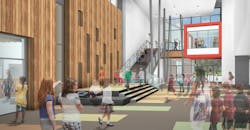Cost estimating for K-12 school projects: An invaluable tool for budget management
As school districts nationwide plan for long-term maintenance and construction costs, they share a number of common concerns. Districts ask:
• How much is a typical monthly maintenance bill, and what does it include?
• How much does it cost to bring a school up to 21st century learning standards?
• How much would it cost to build new?
• What’s the monthly maintenance cost difference between a renovated building and a new facility?
• What is the up-front cost difference between renovation and new construction?
Understandably, clients want to be able to track costs at every stage of a project, and cost estimates (current and life cycle) are valuable planning and design tools.
To assist our education clients in informed decision making, we use a detailed preliminary cost estimate which reflects the total project cost, not just the construction cost. Soft costs beyond construction can include land, FF & E, surveys, testing, design fees, escalation, owner contingencies, and other elements. Budgets for public work are typically all inclusive, so the total project cost has to stay within the set budget. Tracking total project costs throughout each design phase provides a much clearer picture than construction costs alone.
A line-item spreadsheet for hard and soft costs is an important decision-making tool throughout the design process, helping clients to prioritize spending. For example, buying new land for $1 million means $1 million less spent on building square footage or technology, while reusing technology, equipment, and furniture from another facility may allow a school system to build more classrooms.
The project timeline is a critical factor in cost estimating; typically, the longer the schedule, the more construction costs are likely to escalate over time. We generally estimate for 2-3% escalation a year for labor and materials, though unforeseen disasters such as hurricanes can significantly impact the cost of labor and materials and make costs challenging to predict over the long term.
Programming and Analysis
Whether the project is a renovation or new construction, cost control begins at the earliest project stages. Simultaneous programming and cost estimating helps districts visualize in real time how each program space impacts the budget, helping to keep design goals and budget aligned.
The design team works closely with stakeholders to create a programming document based on the district’s goals, needs, vision, and typical space requirements for each program requirement. This document is the basis for a preliminary construction cost estimate with line-item hard and soft project costs.
At this stage, the team will also analyze life cycle costs for major systems such as HVAC and lighting. This Life Cycle Assessment (LCA) helps clients understand both first costs and long-term costs, and is a powerful tool for making decisions about mechanical and electrical systems. Often, up-front investments in high-performance systems can offset long-term maintenance and operational costs, saving money over the life of the system.
Refining the Process
By the end of the design development phase, the district will have a clearer picture of building size, construction type, finish materials, quantities, mechanical systems, and site utilities which will be factored into a refined cost estimate.
With this additional level of detail, a cost estimator or GC estimating group can provide a more accurate estimate of construction costs based on market and regional trends. This estimate may inform adjustments to the design to help align the program and budget.
Innovative design and construction strategies may help to complete the project on time, in budget, and at the highest level of quality. For example, an early grading or site package is often used to accelerate construction (and thus potentially reduce costs) while the rest of the building package is still in design development. Furthermore, after the project is complete, documentation of operational costs and building performance over time can provide essential metrics for estimating future projects (both for the district and for the designers).
Transparency Is Key
Ideally, every project would start with a clear and realistic cost estimate that can be monitored and updated from start to finish. Communication and transparency are always critical to a successful project, most especially in ongoing project cost discussions. Districts and designers can set the team up for success by creating a plan for programming and cost estimating at the outset with the goal of aligning expectations, managing uncertainty, and avoiding “scope creep.”
Cost estimates must be as realistic as possible to be useful planning tools. If cost estimates are accurate and are updated at each stage of the design, they can be invaluable in helping stakeholders visualize the “domino effect” impacts and trade-offs of each program space and support wise decisions throughout the process.
